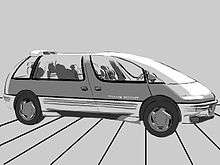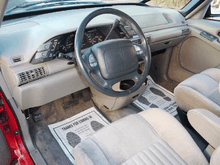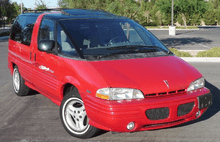Pontiac Trans Sport
| Pontiac Trans Sport | |
|---|---|
 | |
| Overview | |
| Manufacturer | Pontiac (General Motors) |
| Production | 1989–1998 |
| Model years | 1990–1999 |
| Body and chassis | |
| Class | Minivan |
| Layout | Transverse front-engine, front-wheel drive |
| Platform | U-body |
| Chronology | |
| Successor | Pontiac Montana |
The Pontiac Trans Sport and its siblings, the Chevrolet Lumina APV and Oldsmobile Silhouette were a set of minivans that débuted with radical styling in fall 1989 as 1990 models. There was also a Chevrolet Trans Sport sold in Europe until 2005 that was a version of the Chevrolet Venture that had some features of the Pontiac Trans Sport. Production of the Trans Sport was ended in 1998.
Background
The Trans Sport and its sibling models were produced by General Motors to compete with the Dodge Caravan and Plymouth Voyager. Because the larger Chevrolet Astro and the GMC Safari "mini-vans" were based on a body-on-frame, rear wheel drive truck platform, they appealed to a different segment of the market and did not put a significant dent in Chrysler's almost complete dominance of the minivan market in the late eighties. The GM minivans, while more successful than the Astro/Safari duo in terms of market share, weren't able to capture a large chunk of the market away from the Chrysler models.
Original concept

First shown to the public in 1986, the Pontiac Trans Sport concept car was extremely well received. It featured futuristic styling, individually removable bucket seats with built-in stereo speakers, a gull-wing rear passenger door and extensive use of glass including a glass-paneled roof as well as many other "dream car" features such as a built-in Nintendo Entertainment System. The original concept version of the Trans Sport was placed on display in the TransCenter post-show area of the former Epcot attraction, World of Motion, at Walt Disney World, which was sponsored by General Motors.
Based on the warm reception the concept vehicle received, the Pontiac Trans Sport was approved for production in 1987. However, as is often the case, the styling and features showcased on the concept did not make the translation to the mass-produced edition. The gullwing door was deemed too expensive to produce and would probably have hit overhead garage doors in suburban garages. The glass roof was too heavy and too expensive, so the resultant production vehicle made-do with high-gloss black painted panels for the roof to suggest the glass canopy the concept sported.
Chevrolet and Oldsmobile were also given production vehicles based on the Trans Sport in order to cover the widest possible range of potential customers. It was intended that the Lumina APV would be the value-priced version, The Trans Sport would net the more sport- and style-oriented buyers, and the Oldsmobile Silhouette would be the minivan for the premium market. The Trans Sport, Lumina APV and Silhouette began production in December, 1989 as 1990 models.
Technology and innovative features


The Trans Sport, as well as its badge engineered variants from Chevrolet and Oldsmobile, rode on the U-body platform and were constructed from a galvanized steel space frame, featuring dent and rust resistant polymer plastic body panels on the side and a galvanized steel roof. This construction set up was also used on the Pontiac Fiero as well as vehicles from GM's Saturn division.
The Trans Sport had three seating options. The base models had standard seating for five, with three, 35lb easily removable bucket seats (called modular seats) in place of a bench seat usually used in minivans. Available on any Trans Sport was seating for seven, which consisted of 5-modular seats covering the rear two rows of seating. The up-level Trans Sport SE and later, the GT featured available seating for 6. This created a 2+2+2 style.
Included with the level ride package, which utilized a compressor and air-pressurized rear shock absorbers to maintain vehicle height regardless of load, was a control panel and air hose kit that allowed the vehicle to be used to inflate tires, air mattresses, sporting equipment and the like.
In 1993, GM debuted the first power side sliding door. Due to quality control problems, the option never became available in production models until 1994. 1994 Trans Sports also debuted a driver's side airbag.
For the 1994 and 1995 model years traction control was available with the 3800 engine option. It was standard with the 3.4L V6 engine beginning in 1996.
Modest sales success

The design of these minivans was controversial. At the time that the Pontiac Trans Sport and its siblings were conceived, no one had tried to market a stylish or sporty minivan, and GM felt that this represented a potentially large market segment that the class-leading Chrysler minivans failed to address. They styled these minivans to be lower and sleeker than any of the competing brands on the market. The extremely large, long and sloped windshield and the resultant long distance to the base of the windshield when sitting in the drivers seat made for a disconcerting driving experience until a person could adjust to the "different" proportions. Automotive magazines christened the new minivans "dustbusters" after Black and Decker's trademark for handheld vacuum cleaners, since the minivans shared a similar side profile to the handheld vacuum cleaners.
The first engine in these vans was a meager 3.1 L V6, that produced only 120 hp (89 kW), which was not up to the task of hauling these fairly heavy vehicles around with any authority. In 1992, the Trans Sport and its siblings received the 170 hp (127 kW) 3.8 L 3800 V6 as an option, which provided much better torque and acceleration for the vans, making them the most powerful as well as best handling minivans in production at the time.
In response to criticism (and relatively modest sales) attributable to the vehicles' avant-garde styling, feedback from potential customers, automotive publications, and even chiding in Chrysler Corporation's advertising, in 1994, the Trans Sport and Lumina APV received a facelift, shortening the nose by 3 inches (76 mm) and toning-down of the cladding to effect a more conventional look. Additionally a ridge was added to the interior dashboard to lessen the perceived distance to the base of the windshield.
Europe, which had grown accustomed to sleek minivans thanks to the Renault Espace, did not object to the futuristic styling, and sales were respectable, so the decision was made to retain the original shape on the European version which, from the 1994 model year onwards, was an Oldsmobile Silhouette, transformed into a Pontiac Trans Sport by the addition of Pontiac badging and wheels. Another specificity was the 1995 introduction of a diesel version, vital for the European market. It used a PSA 1.9 litre turbodiesel outputting 90 hp (67 kW) which was clearly underpowered.
Production of this generation of U Platform minivans ceased in 1996, at which time the Tarrytown plant which produced them and had been in operation since 1900 was shuttered and scheduled for demolition.
First Generation
| First Generation | |
|---|---|
 | |
| Overview | |
| Production | 1990–1996 |
| Assembly | Tarrytown, New York, United States |
| Body and chassis | |
| Body style | 3-door van |
| Layout | Transverse front-engine, front-wheel drive |
| Platform | U-body/GMT199 |
| Related |
Chevrolet Lumina APV Oldsmobile Silhouette |
| Powertrain | |
| Engine | |
| Transmission | |
| Dimensions | |
| Wheelbase | 109.8 in (2,789 mm) |
| Length |
1993–96: 194.5 in (4,940 mm) 1990–92: 194.7 in (4,945 mm) |
| Width | 74.6 in (1,895 mm) |
| Height |
1993–96: 65.7 in (1,669 mm) 1990–92: 65.2 in (1,650 mm) |
| Curb weight |
3,600–3,900 lb (1,630–1,770 kg) |
1990
- All new model.
- Available as Trans Sport (with silver cladding) and Trans Sport SE (monochromatic), both offered the 120-hp 3.1L V6 and three-speed automatic.
- Launched in Europe with minor differences in exterior trim required for regulatory concerns as well as engine and transmissions appropriate for Europe's differing fuel cost and vehicle taxation structure. In some European countries sold through Opel dealers.
1991
- Customer complaints regarding glare reflected on the interior of the windshield from the massive expanse of the dashboard led to the addition of black carpeting in lieu of the more reflective plastic used in the previous year.
- Power windows and door locks made standard on American models.
- A manual sunroof was newly available.
1992
- Base model was discontinued and a sporty GT model was added.
- Newly available for 1992 was GM's 3800 V6 engine coupled with a Hydra-Matic 4T60 4-speed electronically controlled automatic transmission. It was standard on the GT, optional for SE.
- With the departure of the base model, silver cladding was no longer available.
- Leather seating became available as an option on the GT model. Previously, leather seating was an Oldsmobile Silhouette exclusive within the U-body minivans.
- The cowl-mounted fixed radio antenna mast was eliminated, and an integrated roof antenna was installed, sandwiched between the roof and the headliner.
- Side view mirrors were changed to the folding type and were enlarged to provide better rear-ward visibility.
- Brakes were enlarged and anti-lock brakes (ABS) was added as standard equipment.
- Steering wheel-mounted controls for the stereo system were added as an option on SE and standard on GT.
1993
- Due to very slow sales in 1992, the Trans Sport GT was dropped after one year. Trans Sport SE continues; it would be the only trim level available from 1993 to 1996. The SE model could be outfitted with any of the GT's options.
- The text badges were changed from black to the van's colours.
- A remote controlled power sliding side door was announced for 1993, but failed to actually make it into production that year due to quality control problems.
- A new color scheme with gold cladding, gold wheels and a body-colored roof behind the C-pillar was available as an extra-cost option with certain exterior colors.
- A redesigned center console was added this year with revamped, larger climate controls, a large storage cubby and a large storage bin at its base.
1994

- The exterior styling was revamped, three inches (76 mm) were trimmed off the nose. Headlights taken from the Pontiac Bonneville were installed with Bumper-mounted fog lamps added as standard equipment and cladding was made less flamboyant and stylized.
- In an effort to lessen the perceived distance to the base of the windshield, a ridge was added to the interior dash finishing panel.
- The power sliding door became available as an option, after being introduced in 1993.
- Built-in child seats for the second row became available as an option.
- A traction control system became available as an option with the 3.8L V6.
- Rear deep-tinted windows now featured a darker tint than previously used.
- A driver's side airbag became standard equipment.
1995
- Automatic power door locks that engaged/disengaged with the transmission shifting into or out of "park" added as a standard feature of the power door lock option package.
- Rear portion of the roof, behind the C-pillar previously painted black as standard with body color as a no-cost option, would be only available painted body color as a further effort to "normalize" the vehicles' looks as compared to competitors.
1996
- Both 3.1 and 3.8 L V6 engines dropped, a 3.4 L V6 3400 engine became the only power plant available.
- There were few other changes, due to a completely redesigned 1997 model, to debut in summer 1996.
2nd generation
| Second Generation | |
|---|---|
 | |
| Overview | |
| Also called |
Pontiac Trans Sport Montana (1997 and 1998 for US & 1999 for Canada) Buick GL8 (China) Chevrolet Trans Sport (Europe) Opel Sintra (Europe) Vauxhall Sintra (United Kingdom) |
| Production | 1997–1999 |
| Assembly | Doraville, Georgia, United States |
| Body and chassis | |
| Body style |
3-door van 4-door van |
| Platform | U-body/GMT200 |
| Related |
Chevrolet Venture Oldsmobile Silhouette |
| Powertrain | |
| Engine | 3.4 L (207 CID) LA1 3400 V6 |
| Transmission | 4-speed automatic |
| Dimensions | |
| Wheelbase |
SWB: 112.0 in (2845 mm) LWB: 120.0 in (3048 mm) |
| Length |
SWB: 187.3 in (4757 mm) LWB: 201.3 in (5113 mm) |
| Width | 72.7 in (1847 mm) |
| Height |
SWB: 67.4 in (1712 mm) LWB: 68.1 in (1730 mm) |
1997–1999
In the 1997 model year, the Trans Sport and its siblings got their first major redesign, ditching the one-of-a-kind construction and look to create a more conservative, conventional minivan. Gone were spaceframes, plastic body panels, and sleek styling. The new minivans were of unibody steel construction and the styling was intentionally conventional to such an extent that contemporary reviewers remarked that without looking closely at the badging and grille treatments, these minivans could be mistaken for their primary competitors, the Dodge Caravan and Plymouth Voyager, which at the time commanded a 50% share of the minivan market. The last model year for the Trans Sport was 1998 in the U.S. and 1999 in Canada. The Doraville, Georgia assembly plant that produced the Trans Sport closed on September 26, 2008.
Safety criticism

A crash test video[1] of the 1997-2004 Trans Sport/Montana resulted in criticism because of extreme damage to the vehicle in the 40 mph (64 km/h) crash test. The minivan received a "Poor" rating by the Insurance Institute for Highway Safety (IIHS), and some comments made by the IIHS were
- Major collapse of the occupant compartment left little survival space for the driver.
- Extreme steering wheel movement snapped the dummy's head backward.
- The unnatural position of the dummy's left foot indicates that an occupant's left leg would have been seriously injured in a real-world crash of this severity.
- The forces on the left lower leg were so high that the dummy's metal foot broke off at the ankle.
European market

This version of the Pontiac Trans Sport was also sold in Europe as a Chevrolet, alongside the Opel/Vauxhall Sintra; however, unlike the Sintra, which was based on the Pontiac Trans Sport, Pontiac Montana, Chevrolet Venture, Oldsmobile Silhouette and the previous generation Buick GL8, but wore the European Opel or British Vauxhall badges and trim, the Chevrolet Trans Sport (as it was known) was trimmed and badged exactly like the Pontiac Trans Sport, the only differences being where Chevrolet badges were used in place of the Pontiac badges. In all cases, the European-market vans used different front, side and rear lighting equipment, different seat belts and sundry other safety items, to comply with ECE regulations which differ from US safety standards. These models were discontinued between 2003 and 2005, depending on the market. Despite limited sales in most of Europe, the vehicle was particularly successful in Sweden - where it was the best selling minivan for a while. While production ended in 2005, European stock lasted until 2007.
1997–2005

- See Pontiac Montana
For the 1997 and 1998 model year (1999 in Canada), along with the roll out of this new generation of minivans, the Pontiac (Trans Sport) Montana was debuted, which had special cladding and wheels intended to give it a more rugged SUV-like appearance. In the 1999 model year (2000 in Canada), the name "Trans Sport" was dropped due to the popularity of the "Montana" appearance package. By the time the "Trans Sport" moniker was dropped, the "Montana" package accounted for over 80% of total Trans Sport sales. This also had to do with the fact that Montana become popular as an advertising name for several products in general around this time.
Engine:
See also
References
- ↑ StickyCheese2000. "Why do people buy a Montana? Another video about its safety". YouTube. Retrieved 2011-11-27.
External links
| Wikimedia Commons has media related to Pontiac Trans Sport. |
| « previous — Pontiac, a division of General Motors, automobile timeline, 1980s–2010 | |||||||||||||||||||||||||||||||
|---|---|---|---|---|---|---|---|---|---|---|---|---|---|---|---|---|---|---|---|---|---|---|---|---|---|---|---|---|---|---|---|
| Type | 1980s | 1990s | 2000s | 2010 | |||||||||||||||||||||||||||
| 0 | 1 | 2 | 3 | 4 | 5 | 6 | 7 | 8 | 9 | 0 | 1 | 2 | 3 | 4 | 5 | 6 | 7 | 8 | 9 | 0 | 1 | 2 | 3 | 4 | 5 | 6 | 7 | 8 | 9 | 0 | |
| Subcompact | Sunbird | T1000 | 1000 | LeMans | Matiz/G2 | Matiz/Matiz G2 | |||||||||||||||||||||||||
| Acadian | |||||||||||||||||||||||||||||||
| Sunburst | |||||||||||||||||||||||||||||||
| Firefly | Firefly | Firefly | Firefly | Wave | G3 | ||||||||||||||||||||||||||
| Compact | J2000 | 2000 | Sunbird | Sunbird | Sunfire | Pursuit/G4/G5 | |||||||||||||||||||||||||
| Tempest | Vibe | Vibe | |||||||||||||||||||||||||||||
| Phoenix | Grand Am | Grand Am | Grand Am | G6 | |||||||||||||||||||||||||||
| Mid-size | LeMans | Bonneville | Grand Prix | Grand Prix | Grand Prix | ||||||||||||||||||||||||||
| Grand Am | 6000 | ||||||||||||||||||||||||||||||
| Full-size | Laurentian | ||||||||||||||||||||||||||||||
| Catalina | |||||||||||||||||||||||||||||||
| Parisienne | Bonneville | Bonneville | Bonneville | G8 | |||||||||||||||||||||||||||
| Bonneville | |||||||||||||||||||||||||||||||
| Station wagon | Safari | ||||||||||||||||||||||||||||||
| Mid-size crossover | Aztek | Torrent | |||||||||||||||||||||||||||||
| Compact SUV | Sunrunner | ||||||||||||||||||||||||||||||
| Minivan | Trans Sport | Trans Sport/Montana | Montana SV6 | ||||||||||||||||||||||||||||
| Personal luxury | Grand Prix | ||||||||||||||||||||||||||||||
| Muscle car | Firebird | Firebird | Firebird | GTO | |||||||||||||||||||||||||||
| Sports | Fiero | Solstice | |||||||||||||||||||||||||||||
| Red denotes models which are exclusive to Canada | |||||||||||||||||||||||||||||||
| Green denotes models which are exclusive to Mexico | |||||||||||||||||||||||||||||||